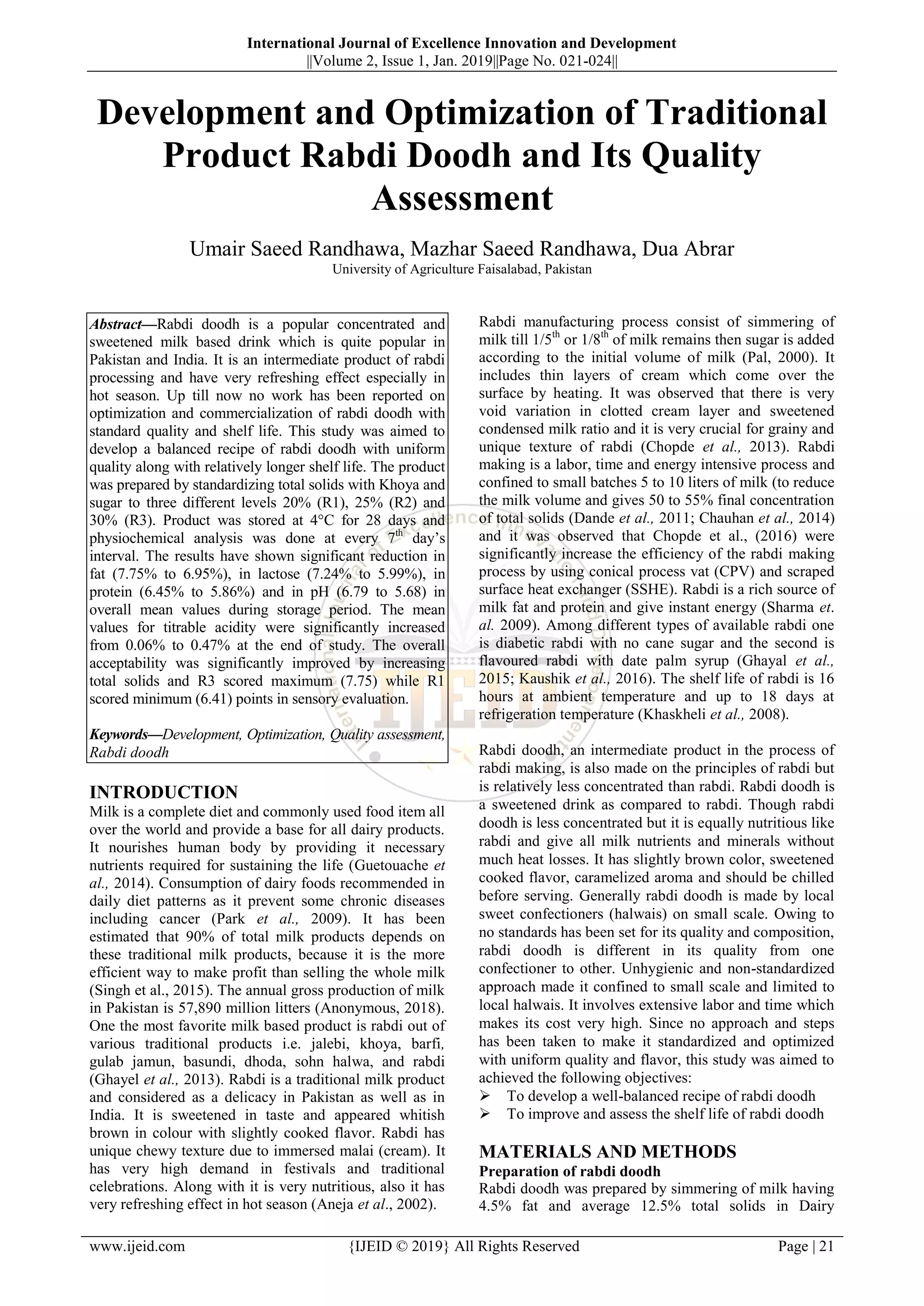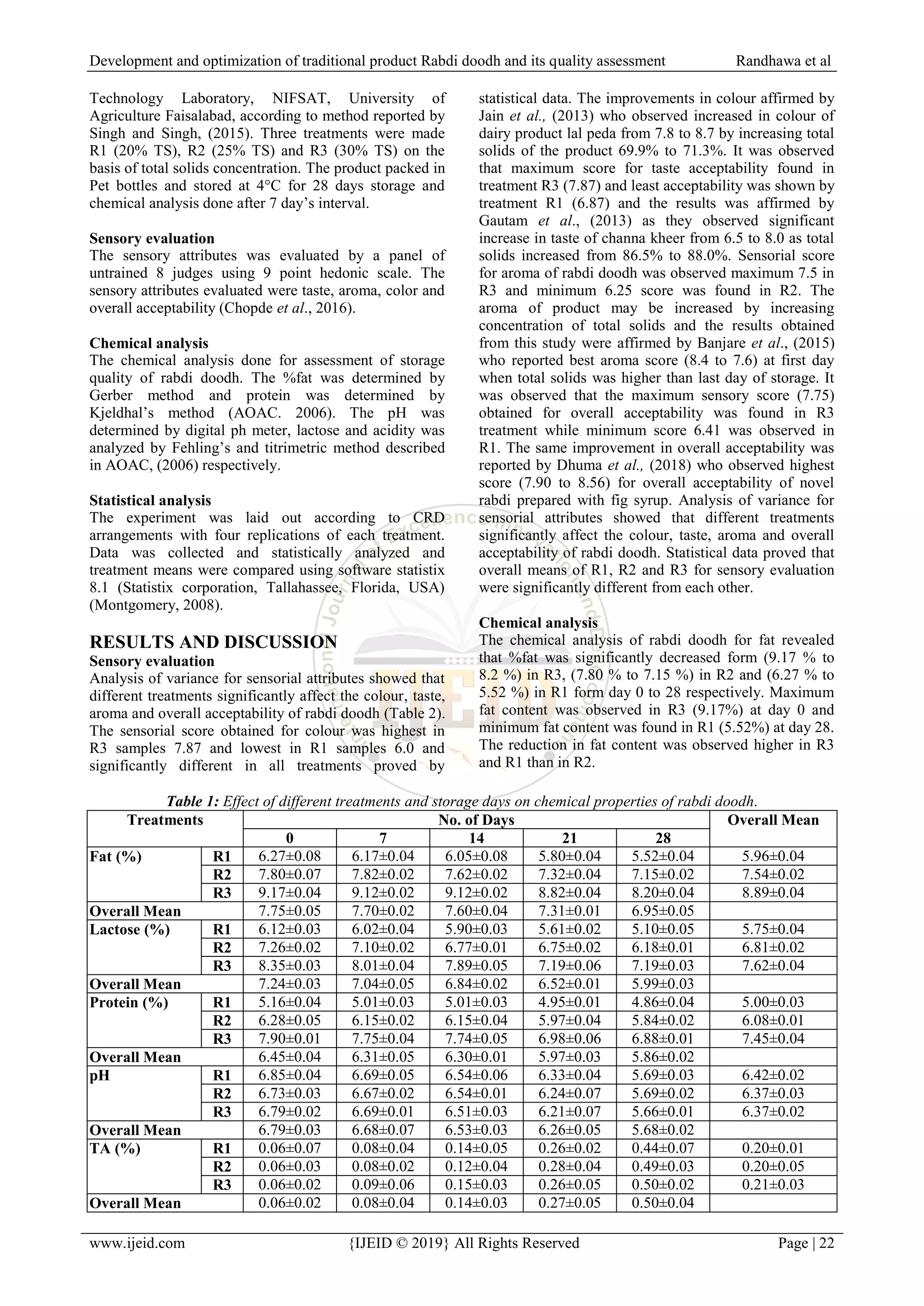The study focuses on the development and optimization of rabdi doodh, a sweetened milk-based drink popular in Pakistan and India, aiming to standardize its quality and extend its shelf life. Various formulations were tested by adjusting total solids, showing significant improvements in sensory attributes and reduction in fat, lactose, and protein over 28 days of storage. The best formulation resulted in higher overall acceptability based on sensory evaluations, highlighting the potential for commercialization of rabdi doodh.


![International Journal of Excellence Innovation and Development
||Volume 2, Issue 1, Jan. 2019||Page No. 021-024||
www.ijeid.com {IJEID © 2019} All Rights Reserved Page | 23
Table 2: Effect of different treatments on sensorial attributes of rabdi doodh.
Treatments Mean (/9)
Colour Taste Aroma Overall acceptability
R1 6.0±0.43 6.87±0.54 6.25±0.58 6.41±0.37
R2 6.87±0.65 7.0±0.38 6.37±0.45 6.70±0.42
R3 7.87±0.27 7.87±0.24 7.50±0.76 7.75±0.66
A similar trend was observed in the rabdi samples as the
fat content was decreased (from 20.58 % to 19.22 % and
21.58 % to 20.22 %) at both ambient and refrigeration
temperatures reported by Singh and Singh, (2015).
It was observed that lactose content of the product
significantly reduced from day 0 to 28. The lactose
content was reduced form (8.35 % to 6.67 %) in R3,
(7.26 % to 6.18 %) in R2 and (6.12 % to 5.10 %) in R1
from day 0 to 28 respectively. The maximum lactose
content was found in treatment R3 8.35% at day 0 and
minimum was observed in treatment R1 5.10% at day
28. There were similar reductionof lactose content
decreased from 13.65 % to 13.29 % in basundi may be
caused by conversion of lactose into basic units’ glucose
and galactose reported by Gaikwad and Hembade,
(2013).
It was observed that maximum protein content was fount
7.9% in R3 at day 0 and minimum was observed 4.86%
in R1 at day 28. The protein content of rabdi doodh was
significantly decreased from day 0 to 28 as it reduced
from (7.9 % to 6.88 %) in R3, (6.28 % to 5.84 %) in R2
and (5.16 % to 4.86 %) in R1. The reduction of protein
content in this study affirmed by Singh and Singh,
(2015) as they observed protein content decreased from
(10.58%) to (8.50%) in rabdi during 0 to 12 days of
storage at refrigeration temperature.
The significant increase in titrable acidity observed from
day 0 to day 28 of storage for all three treatments. The
average TA values significantly increased from (0.06 %
to 0.50 %) in R3, (0.06 % to 0.49 %) in R2 and (0.06 %
to 0.44 %) in R1 from day 0 to 28 respectively. The
values for TA was observed higher in R3 throughout the
storage period. The increased in TA may be caused by
increase in microbial activity in product reported by
Banjare et al., (2015) in peda as TA was increased from
0.41% to 0.50 % at day 1 to 12, and Kaushik et al.,
(2016) observed in rabdi the TA was increased from
0.054% to 0.44% at 0 to 20 respectively.
The chemical analysis revealed that pH of product was
decreased from (6.85 to 5.69) in R1, (6.73 to 5.69) in R2
and (6.79 to 5.66) in R3 from day 0 to day 28
respectively. The maximum value for pH was observed
in treatment R1 6.85 at day 0 and minimum pH was
observed in R3 6. 66 at day 28. The reduction in pH may
be caused due to increase in acidity of the product
reported by Singh and Singh, (2015) who observed
significant pH reduction (6.63 to 5.30) for 12 days of
storage in rabdi samples.
The analysis of variance proved that the fat, lactose,
protein, of the product significantly (p≥0.001) affected
by different number of days and different treatments of
the product and combined action of treatments and
number of days. The pH and titrable acidity of the
product was significantly (p≥0.001) affected by different
number of days but it was non-significantly (p≤0.05)
affected by different treatments and combined action of
both evident from analysis of variance.
CONCLUSION
The sensory and chemical parameters results showed the
treatment R3 scored highest among oher two treatments
R2 and R1 in terms sensorial overall acceptability along
with good keeping quality of the product at 4°C. During
storage of rabdi samples it was observed that the
physiochemical parameters was changed least but
significantly from day 0 to 14 and the changes were at
faster pace after 14 day at refrigeration temperature. The
chemical parameters i.e. fat, lactose, protein and pH
were significantly reduced while total acidity was
significantly increased from day 0 to 28.
REFERENCES
[1] Anonymous. 2018. Pakistan Economic Survey
2017-18. Ministry of Finance, Government of
Pakistan.
[2] AOAC. 2006. Official methods of analysis of
association of official analytical chemists
international. In: Horwitz, W. 18th ed. AOAC
press, Arlington, VA, USA. Pp: 1-48.
[3] Aneja, R.P., B.N. Mathur, R.C. Chandan and A.K.
Banerjee. 2002. Desiccated milk based products
In: Technology of Indian Milk Products. Dairy
India Publication. Delhi.pp:125.
[4] Banjare, K., M. Kumar and B.K. Goel. 2015.
Effect of storage on chemical, textural and
sensory attributes of traditional indigenous sweet
peda. Asian Journal of Dairy & Food Research.
34:104-108.
[5] Chauhan, A.S., S.P. Singh, K.V. Singh and S J.
Singh. 2014. Effect of different types of milk on
shelf life and microbial quality of rabdi. Indian
Journal of Science and Technology. 7:1039–1042.
[6] Chopde, S., B. Kumar and P. Minz. 2016. Process
optimization for in-line production of rabdi. Asian
Journal for Dairy and Food Research. 35:10-16.
[7] Chopde, S.S., B. Kumar, P.S. Minz and P. Sawale.
2013. Feasibility study for mechanized production
of rabdi. Asian Journal of Dairy and Food
Research. 32:30-34.
[8] Dande, K.G.; S.M. Gaikwad and, A.K.M. Shaikh.
2011. Utilization of solar energy in dehydration of
milk and in the manufacturing of Khoya. African
Journal of Food Science. 5: 814-816.
[9] Dhuma, C.Y., J.K. Dhemre, R.J. Desale, M.B.
Shete and S.N. Ambad. 2018. Preparation of
Rabdi from Stored Concentrated Fig (Ficus carica](https://image.slidesharecdn.com/ijeid201021024-190210090910/75/Development-and-Optimization-of-Traditional-Product-Rabdi-Doodh-and-Its-Quality-Assessment-3-2048.jpg)
![Development and optimization of traditional product Rabdi doodh and its quality assessment Randhawa et al
www.ijeid.com {IJEID © 2019} All Rights Reserved Page | 24
L.) Pulp. International Journal of Current
Microbiology and Applied Sciences. 7: 2319-
7706.
[10] Gautam, A., A. Jha and R. Singh. 2013. Sensory
and textural properties of chhana kheer made with
three artificial sweeteners. International Journal of
Dairy Technology. 66:109-118.
[11] Gaikwad, S.M. and A.S. Hembade. 2013. Effect
of storage temperature on shelf life of
standardized buffalo milk Ujani basundi. Global
Journal of Dairy Farming and Milk Production.
1:26-31.
[12] Ghayal, G., A. Jaha, A. Kumar, A.G. Gautam and
P. Rasane. 2015. Effect of modified atmospheric
packaging on chemical and microbial changes in
dietetic rabdi during storage. Journal of Food
Science and Technology. 53:1825-1829.
[13] Guetouache, M., G. Bettache and M. Samir. 2014.
Composition and nutritional value of raw milk.
Issues in Biological Sciences and Pharmaceutical
Research. 2:115-122.
[14] Ghayal, G., A. Jha, J.k. Sahu, A. kumar, A.
Gautam, R. kumar and P. Rasane. 2013. Moisture
sorption isotherms of dietetic Rabdi at different
storage temperatures. International Journal of
Dairy Technology. 66:587-594.
[15] Jain, P., A. kumar, A. Jha, R. kumar and S.k.
Pandey. 2013. Textural and sensory properties of
Lal peda manufactured with artificial sweeteners
and bulking agents. International Journal of Dairy
Technology. 66:119-126.
[16] Kaushik, M., C. Prakash, L. Kumar. 2016. Studies
on preparation of rabdi using date syrup as sugar
substitute. International Journal for Scientific
Researches. 5:1183-1188.
[17] Khaskhali, A., A. Jamali, M.A. Arain, A.H.
Nizamani, A.H. Soomro and H.H. Arain. 2008.
Chemical and sensory quality of indigenous milk
based product rabdi. Pakistan Journal of Nutrition.
7:133-136.
[18] Montgomery, D.C., 2008. Design and Analysis of
Experiments: Students Solutions Manual. 7th
ed.
John Wiley & Sons, Inc. Hoboken.
[19] Pal, D. 2000. Technological advances in
manufacture of heat desiccated traditional Indian
milk products-an overview. Indian Dairyman.
50:52:27.
[20] Park, Y., M.F. Leitzmann, A.F. Subar, A.
Hollenbeck and A. Schatzkin. 2009. Dairy food,
Calcium, and risk of cancer in the NIH-AARP
Diet and Health Study. Archived International
Medication. 169:391–401.
[21] Singh, S.J., A.S. Chauhan, M.P. Singh, P.K.
Upadhyay and M.P. Singh. 2015. Nutritional
study of simmering and concentration methods
based nutritional product. Journal of Research for
Environment and. Life Sciences. 8:91-94
[22] Sharma, P., R.R.B. Singh, A.K. Singh, A.A. Patel
and G.R. Patil. 2009. Sorption isotherms and
thermodynamics of water sorption of ready to use
basundi mix. Food Science and Technology.
42:441–445.](https://image.slidesharecdn.com/ijeid201021024-190210090910/75/Development-and-Optimization-of-Traditional-Product-Rabdi-Doodh-and-Its-Quality-Assessment-4-2048.jpg)